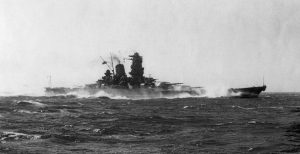Is the fundamental technological story of naval battle in the Pacific War wrong? For a very long time, the narrative of the relative effectiveness of battleships and aircraft carriers has been told as one of stunning reversal, with the Pearl Harbor attack and the sinking of two British battleships off Malaya confirming the primacy of airpower (naval or no) and the obsolescence of the battleship. While historians have always had reservations about this narrative, it has retained a firm popular grip and substantial scholarly support. However, a new article in the Journal of Military History argues that the advantages of aircraft carriers over battleships has been wildly overstated in historical memory of World War II, even in the Pacific. James FitzSimonds argues that battleships remained central to naval power in the Pacific, even into 1944 and 1945 when the great U.S. Navy carrier task forces seemed to dominate the sea.
FitzSimonds argues that carrier aircraft lacked the ability to reliably sink or even damage battleships operating at sea, or sitting at port under guarded conditions. Very few battleships fell victim solely to attack by carrier aircraft, and that only in 1944 and 1945 when U.S. advantages were enormous. Explicit in the argument is that Japanese, American, and British admirals could have used their battleships more aggressively, even in the face of enemy air superiority. To some extent this is probably true, at least at the margins. Previous scholarly work has explored whether the U.S. Navy used its battleships efficiently during the war, concluding that the survivors of Pearl Harbor were badly under-utilized in 1942 and 1943. And Fitzsimons is probably correct in the implication that the two largest Japanese battleships, Yamato and Musashi, were effectively immune to destruction (if not damage) by carrier-based air in 1942 and 1943. More aggressive use of battleships by both sides in, for example, the Solomon Islands campaign was probably called for.
The argument is undoubtedly provocative, and certainly pushes back against some of the more robust delusions about naval technology in World War II. However, it likely pushes too far. Aircraft carriers often could not kill battleships, but they could cause them damage that left them vulnerable to other killers, such as surface ships and submarines. No battleship captain enjoyed the task of sailing in daylight during constant harassment by carrier aircraft, even if the aircraft could only inflict superficial damage. Moreover, while the ability of carriers to sink battleships was limited, the ability of battleships to sink carriers was virtually nil. Even granting their robust construction and defensive capabilities, battleships simply lacked the carriers ability to detect and attack enemies at range, even if the latter has been consistently exaggerated.
Finally, if battleships were still central to sea control, then why did battleships end? The U.S. Navy stopped construction on two Iowa-class battleships at the end of World War II. Great Britain completed HMS Vanguard in 1946, but rejected the idea of constructing the follow-on “Lion” class battleships in the late 1940s. Similarly, France completed the Jean Bart, but never pressed her into full service. The Soviets maintained plans to build battleships into the early 1950s, but those died along with Stalin.
Indeed, by the 1950s, it had become apparent that even the costs of operating existing battleships, much less building new ones, exceeded the benefits that such ships presented. The French Navy discovered that employing battleships in a limited headquarters and shore bombardment role was not economical. All of the Royal Navy’s battleships left service by the early 1950s. Only the United States retained battleships in serviceable condition for any extended period. The fleet dwindled from 25 at the end of the war to 17 front line and reserve ships by 1950, then to only four by the early 1960s.
Altogether, the article represents an interesting intellectual exercise, and a useful corrective to popular views of the enduring utility of the battleship, but likely goes too far in its assertion regarding the centrality of the battleship to operations during the war. Still, this has an impact on contemporary debates about the aircraft carrier (which often reference the rapid obsolescence of the battleship), and so complicating the story of the Pacific War undoubtedly has some value.

































